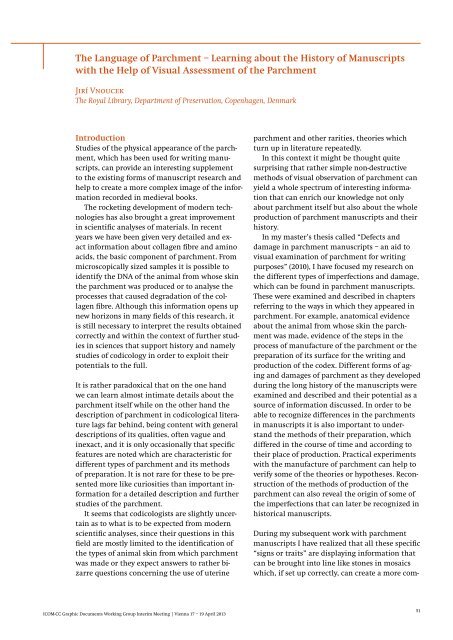Paper Conservation: Decisions & Compromises
Paper Conservation: Decisions & Compromises
Paper Conservation: Decisions & Compromises
Create successful ePaper yourself
Turn your PDF publications into a flip-book with our unique Google optimized e-Paper software.
The Language of Parchment – Learning about the History of Manuscripts<br />
with the Help of Visual Assessment of the Parchment<br />
Jirí Vnoucek<br />
The Royal Library, Department of Preservation, Copenhagen, Denmark<br />
Introduction<br />
Studies of the physical appearance of the parchment,<br />
which has been used for writing manuscripts,<br />
can provide an interesting supplement<br />
to the existing forms of manuscript research and<br />
help to create a more complex image of the information<br />
recorded in medieval books.<br />
The rocketing development of modern technologies<br />
has also brought a great improvement<br />
in scientific analyses of materials. In recent<br />
years we have been given very detailed and exact<br />
information about collagen fibre and amino<br />
acids, the basic component of parchment. From<br />
microscopically sized samples it is possible to<br />
identify the DNA of the animal from whose skin<br />
the parchment was produced or to analyse the<br />
processes that caused degradation of the collagen<br />
fibre. Although this information opens up<br />
new horizons in many fields of this research, it<br />
is still necessary to interpret the results obtained<br />
correctly and within the context of further studies<br />
in sciences that support history and namely<br />
studies of codicology in order to exploit their<br />
potentials to the full.<br />
It is rather paradoxical that on the one hand<br />
we can learn almost intimate details about the<br />
parchment itself while on the other hand the<br />
description of parchment in codicological literature<br />
lags far behind, being content with general<br />
descriptions of its qualities, often vague and<br />
inexact, and it is only occasionally that specific<br />
features are noted which are characteristic for<br />
different types of parchment and its methods<br />
of preparation. It is not rare for these to be presented<br />
more like curiosities than important information<br />
for a detailed description and further<br />
studies of the parchment.<br />
It seems that codicologists are slightly uncertain<br />
as to what is to be expected from modern<br />
scientific analyses, since their questions in this<br />
field are mostly limited to the identification of<br />
the types of animal skin from which parchment<br />
was made or they expect answers to rather bizarre<br />
questions concerning the use of uterine<br />
parchment and other rarities, theories which<br />
turn up in literature repeatedly.<br />
In this context it might be thought quite<br />
surprising that rather simple non-destructive<br />
methods of visual observation of parchment can<br />
yield a whole spectrum of interesting information<br />
that can enrich our knowledge not only<br />
about parchment itself but also about the whole<br />
production of parchment manuscripts and their<br />
history.<br />
In my master’s thesis called “Defects and<br />
damage in parchment manuscripts – an aid to<br />
visual examination of parchment for writing<br />
purposes” (2010), I have focused my research on<br />
the different types of imperfections and damage,<br />
which can be found in parchment manuscripts.<br />
These were examined and described in chapters<br />
referring to the ways in which they appeared in<br />
parchment. For example, anatomical evidence<br />
about the animal from whose skin the parchment<br />
was made, evidence of the steps in the<br />
process of manufacture of the parchment or the<br />
preparation of its surface for the writing and<br />
production of the codex. Different forms of aging<br />
and damages of parchment as they developed<br />
during the long history of the manuscripts were<br />
examined and described and their potential as a<br />
source of information discussed. In order to be<br />
able to recognize differences in the parchments<br />
in manuscripts it is also important to understand<br />
the methods of their preparation, which<br />
differed in the course of time and according to<br />
their place of production. Practical experiments<br />
with the manufacture of parchment can help to<br />
verify some of the theories or hypotheses. Reconstruction<br />
of the methods of production of the<br />
parchment can also reveal the origin of some of<br />
the imperfections that can later be recognized in<br />
historical manuscripts.<br />
During my subsequent work with parchment<br />
manuscripts I have realized that all these specific<br />
“signs or traits” are displaying information that<br />
can be brought into line like stones in mosaics<br />
which, if set up correctly, can create a more com-<br />
ICOM-CC Graphic Documents Working Group Interim Meeting | Vienna 17 – 19 April 2013<br />
51
















